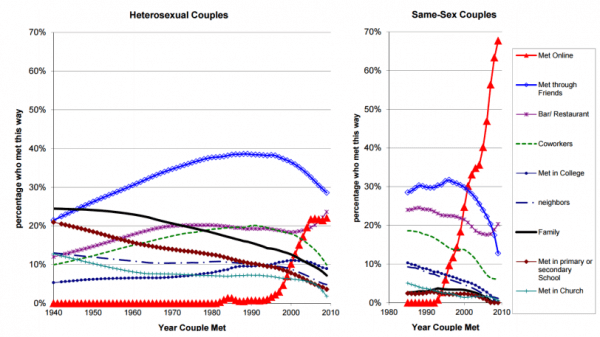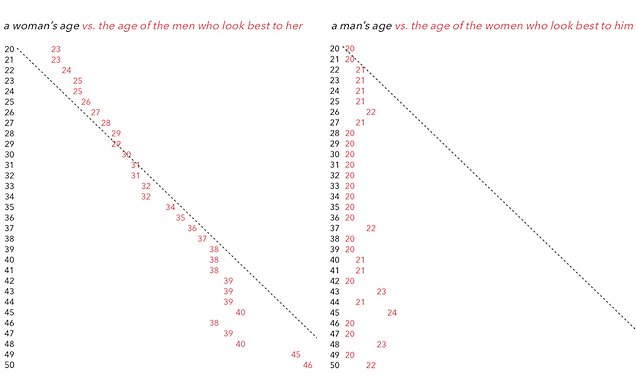
In the earlier days of the internet, people might have come across someone they liked via chatrooms, but we have better options now. Online dating started out in 1995 (thanks to Match.com) and since then, it’s estimated that 1 in 3 marriages start online. Online dating is different from social media because social media relies on the connections you make. It’s only through those people that you have a web of connections but that doesn’t necessarily open up dating prospects. Looking for a woman over 35 in Salt Lake City who likes to bike? That’s what dating sites and apps do for you, they help you search for and connect with desirable strangers.

Tinder has become a staple dating app for millennials and is currently one of the top dating apps period. With so many users on a variety of platforms, it seems like everyone’s meeting online, which can be great but has its share of issues.
Social Impacts
The internet lets us connect with anyone, which has made finding dates much easier. You can message someone without needing their phone number, Google someone, and pick and choose preferred options. However, there are plenty of downsides to online dating. Being online makes people less inhibited and this often leads to harassment. A funny and sad reflection of modern technology is the stream of unsolicited, sexually aggressive photos men seem to get send. Online disinhibition make people feel like they can share their most impulsive (and sometimes never appropriate) opinions.
New unspoken rules and phenomena emerge from these dating sites, like ghosting or catfishing (MTV even made a show about this). Proving your love and commitment can mean deleting all your dating apps (because infidelity is still an issue on the internet). And while many platforms may have started out with a heteronormative narrative, there are now apps for gay men, millionaires, shrinking religions, and other sub-groups. There’s even an app that only let’s women make the first move and search for a BFF at the same time.
But in the same way the internet finds love for people, it brings together another group of people who harbor dangerous feelings of resentment. Online dating can make people feel worse about themselves than when they started. The kind of ‘lookism’ that’s highlighted by wanting to look better on profile pictures and comparing ourselves to other people has lowered self-esteem. Women’s appearances are usually under scrutiny and judgement, but men’s insecurities have also been targeted in recent years and proving to be profitable market. And it gets worse when you throw intersectionality, discrimination, and consent issues in the mix. Remember, these problems exist online because people are terrible in real life. So the capacity of an amazing dating experiences is balanced by the incidents of heinous ones.
What does the data tell us?
There are enough first dates stories to tell us that every interaction we have with a potential partner can be anything between terrible and wonderful. To help with that, online dating creates parameters to help define people and find what they’re looking for. So creators must aggregate data about users to isolate their needs and the best way to . Then the data analysis doesn’t stop. We’ve learned some interesting trends in online dating, some trends less enjoyable than others.
- Both men and women seem to reach out to potential partners slightly more desirable than their selves.
- Women send more positive messages when trying to “upgrade” while men send less positive messages.
- Gross misogynistic trends reveal how women peak at 18 while men peak at 50
- And women with postgrad education are less desirable by men
 Ashley Madison, a notorious dating site for adulterous indiscretions, attracts the sub-category of married people looking to cheat. But the surprising (and hilarious) data was that the site used chatbots to try and lure more customers. There were fewer women signing up, but the site needed to maintain the male customer base. Data showed us that of the supposed millions of women on the site, less than 15,000 were real women (which Ashley Madison denied) and men were likely chatting up a lovely unmarried bot. Dating potential is also judged (harshly) by race. Your desirability, with no other details, is at the mercy of sexual racism. In the US, Asian men and Black women are the least likely to get messages., but Asian women are popular. Racist “preferences” coined as yellow fever or jungle fever, fetishizes race over the individual. This can ruin someone’s online experience even before dating anyone and who knows how else things can go wrong. Of course, the data speaks on averages and specific locations so don’t dismiss online dating completely, it’s still a great way to meet people
Ashley Madison, a notorious dating site for adulterous indiscretions, attracts the sub-category of married people looking to cheat. But the surprising (and hilarious) data was that the site used chatbots to try and lure more customers. There were fewer women signing up, but the site needed to maintain the male customer base. Data showed us that of the supposed millions of women on the site, less than 15,000 were real women (which Ashley Madison denied) and men were likely chatting up a lovely unmarried bot. Dating potential is also judged (harshly) by race. Your desirability, with no other details, is at the mercy of sexual racism. In the US, Asian men and Black women are the least likely to get messages., but Asian women are popular. Racist “preferences” coined as yellow fever or jungle fever, fetishizes race over the individual. This can ruin someone’s online experience even before dating anyone and who knows how else things can go wrong. Of course, the data speaks on averages and specific locations so don’t dismiss online dating completely, it’s still a great way to meet people
What does it teach us?
A lot of this data is pretty depressing. If it’s any indicator of what actual relationships will be, then it doesn’t look good. But we do have to realize that with the social connectivity the internet provides us, we also experience more problems as we interact with more people. We need to learn how to balance the convenience and range of internet connections, but also remember how to socialize with manners and keep up with the changing social climate. 50 years ago, dating apps and sites were unimaginable and people were stuck to the specific time and place they lived in to meet someone. And while some people are awful, trial and error can lead you to a real connection. Or you can have a real-live Tinder race for all the people who swiped right as an experiment.
Get started with our free guide about data visualization and other downloadable resources. See how we can help.
